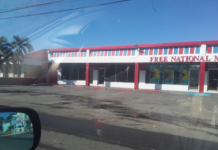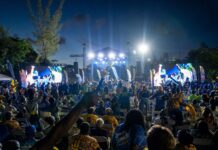
Master boat builder Lauren Knowles of Mangrove Bush, Long Island in front of champion sloop the New Susan Chase. (Photos by Derek Smith)

Huge caves in adventurous Long Island are popular among Bahamians.
By Gladstone Thurston
Deadman’s Cay, Long Island, Bahamas – If current medical research holds true, then the venerable Delbert Carlton Cartwright of the town of Gray’s ought to be made a member of the royal society of cardiologists.
Dell, as he is affectionately called, found out long ago the wholesome influence humor has on one’s overall well-being, how it helps people to relieve stress and to heal. And of that potent potion he is a dispenser of no mean order.
“This young chap went to the police station to get a driver’s licence for his horse,” he told me.
“The police looked at him and said, ‘You think we’re stupid enough to give your horse a driver’s licence?’
“The chap replied, ‘I don’t see why. You give them to jackasses.’”
The path to the door of this national treasure is well-worn by admirers all the way from New York seeking just to sit at his feet and bliss-out on mirth, which is where Julie and I found ourselves the other morning.
A descendant of loyalist settlers, this humble, unpretentious man has been dispensing joy from childhood. At eighty-six, he is just getting better. Long Islanders know only too well that a ball is not a ball without Dell. He has performed before who’s who in the Bahamas.
Married to his beloved Emma for 63 years, Dell made his living as a painter. He earned 6 pence an hour at The Guardian when it was through Charlotte Street. He is also a skilled farmer.
Taking on a grave expression, he looked at me and said, “This Englishman was on his patio having breakfast when a UFO landed in the front of him. Out walked a strange creature.
“Its forehead was where its chin was supposed to be and its chin was on the top of its head. Its nose was on the side of its head and an ear was where an eye should be.
“It poked its head in the Englishman’s face and demanded, ‘I want to see your leader.’
“Replied the Englishman, ‘Nonsense, old chap. Who you need to see is a plastic surgeon.’”
Sir Orville Turnquest, when he was Governor General, made Dell an offer.
As he recalled, “Sir Orville wanted to send me away to New York where, probably, I could make a couple million dollars.
“I said, ‘What am I going to do with it? I have two dollars now and I don’t have anything to spend them on.’
“Money never meant too much to me,” said Dell. “Being happy and contented meant much, much more.”
Cardiologists are just now catching up on what Dell knew long ago, that laughter is indeed the best medicine for the heart.
Another of Long Island’s treasures is Dean’s yawning blue hole, the world’s deepest, descending 663 feet to the ocean floor, according to those who dove it. Long Islanders swear it has no bottom.
It is roughly circular at the surface, with a diameter of about 120 feet. After descending precipitously some 60 feet, the hole widens into a cavern with a diameter of about 330 feet, experts report.
“It gives me the chills,” I told Julie, as we rounded the sandy hill and peered down enchanted by this natural wonder of Bahamaland.
Its clear, glistening, grinning, white sand mouth, merged into aquamarine which itself merge into navy blue and then a bluish-purplish pupil. Craggy cliffs descend some 100 feet.
“This blue hole reminds me too much of Edgar Allen Poe’s hair-graying descent into the maelstrom,” I said. “Folks say sheep and goats that fell in there turned up in the ocean.”
Dean’s Blue Hole reaches out to you in an eerie way. Its gentle surf fair lapped at our toes. A mild northeaster sighed through the eaves of the cove which curved behind a huge limestone bolder.
And no better a place for curvaceous Julie. She is an executive secretary in the financial services industry in Nassau. She promptly stripped to G-string and bared her bun to the sun.
It got me singing, “They are a-sunnin up their buns in Deadman’s Cay with Stephie and Kendra, with Chadese and Freddie. That’s where the sexy Bahamian girls does be. Sunnin up their buns in Deadman’s Cay.”
“This island is a treasure chest,” I said as we turned into the Long Island Library and Museum which tells the story of this industrious people, descendants of loyalists and their slaves, determined to make the best of the hand fate dealt them.
Located 160 miles southeast of Nassau, Long Island comprises 230 square miles. It is just four miles at its widest, but a virtually uninterrupted 80-mile stretch of contrasting coastlines and verdant presentations. It is one of the most visually pleasing of all the islands.
It is characterized by high cliffs on the north side which faces the Atlantic Ocean and shallow sandy beaches on the south side. The tropic of Cancer cuts through the north. Common Long Island family names include Burrows, Cartwright, Carroll, Turnquest, McHardy, Moree, Knowles and Treco.
“I have been coming to Long Island for a long time,” I told Julie. The Ministry of Tourism wants more Bahamians to vacation at home. I was trying to convert her.
“There is something for all tastes,” I added. “I like Long Island for rest and relaxation in a crime-free environment. People come from all over the world for a taste of this paradise. We live here and seem not to appreciate it.”
Called Yuma by the Indians which numbered in the tens of thousands, Long Island was renamed Fernandina by Christopher Columbus in 1492.
After the Indians there was no large permanent settlement until the Loyalists arrived from the Carolinas and Virginia in the 1700s with their African slaves and set up cotton plantations and raised cattle and sheep. By the abolition of slavery in 1834 most of the plantations had collapsed.
Deadman’s Cay in central Long Island is an umbrella district comprising all of the communities stretching from Gray’s in the north to Scrub Hill in the south. It caters to a busy airport.
The social, economic and educational centre of the island, it has seen growth in towns like Buckley’s, Hamilton’s, Petty’s and Cartwright’s, but it suffered the loss of towns like New Hope, Anderson’s, Old Gray’s and Old Joe’s. In 1927 the population of Long Island was more than 7,000. Today it is hovering close to a third of that.
Long Islanders are very hospitable. They always offer salutations every time paths cross. They live close to nature. Cemeteries seem seldom used. Even today everyone’s neighbor is still everyone’s neighbor. Locks are a rarity.
Until the modern era, Bahamians relied on sail boats as a means of inter-island transportation. And, before electricity arrived all the construction was done using hand tools.
Mangrove Bush is the boat building capital of Long Island. We stopped to pay a courtesy call on master boat builder Lauren Knowles.
The Knowles family – Willard, Earle, Rupert, George, Cyril, Bertis, Mark and Stephan, among others – is synonymous with boat building and sloop racing in the Bahamas.
The success of the Susan Chase series of sloops, the Golden Hind, the Legend, and Running Tide and others brought them tons of gold and silverware. The original Tida Wave out of Staniel Cay, perhaps the most successful sloop racer, was built in Mangrove Bush. Mark Knowles is a prolific class ‘C’ builder.
As Queen’s Highway meandered southward, the spires of Monsignor John ‘Jerome’ Hawes‘, masterpieces in Clarence Town – St Paul’s Anglican and St Peter’s Roman Catholic churches – broke the horizon.
As an Anglican architect priest, HYPERLINK “http://www.geographia.com/BAHAMAS/bsciin01.htm” Father Jerome, as he was known throughout the islands, was sent to Long Island to repair Anglican churches. He designed and built St Paul’s and, after his conversion to Catholicism, St Peter’s.
He then moved to Cat Island where he constructed his famous monastery atop Como Hill in New Bight.
The capital of Long Island, Clarence Town has the island’s only safe harbour on the treacherous Atlantic Ocean north side. It has a police station, marinas, accommodations, stores and restaurants. It is visited once weekly by the mail boat from New Providence.
Just south of Clarence Town we found the former slave village, Dunmore’s, named after the Earl of Dunmore, who served as Royal Governor of New York, Virginia and the Bahamas. He operated a plantation there, we were told. Portions of his huge mansion still remain.
Dunmore’s offers a lovely hill-top view of the extensive islet formations that decorate the southern side of central Long Island.
Descendants of Dunmore’s claim Lord Dunmore willed all land comprising his former estate to his slaves and their descendants.
Like Dunmore’s, many of the once bustling towns of southern Long Island are but in name only, we found. It was as if one day everyone just up and departed, leaving everything as they were.
And in that, Bahamians today are given a special treat – an insight into how people lived back then.
The once populous town of Roses stands a stark example. It is frozen in time – a veritable museum of that era. Everything right down to the public lavatory remains intact.
We paid a courtesy call on octogenarian Susannah Martinborough in Mortimer’s at the original Goat Pond Bar, built in the early fifties. She is a history book.
Gordon’s is last community south. It is blessed with a lovely beach which takes up all of a half moon cove featuring some of the finest blend of aquamarine that graced south side.
Stripping to boxers, I joined Julie in the balmy aquatic embrace of the nearby Crooked Island Passage.
“This ain’t bad at all,” she said as we set our sights northward. “I could get use to this.
“There’s history, geography, culture all rolled into one. It’s like going back to your roots.”
Long Islanders are predominantly Anglican. There are Catholics, Baptists, Brethrens and others.
We visited the oldest church, St Mary’s in the Bight, said to have been constructed by Spaniards in the 17th century.
One of the prettiest church settings is that of St Joseph’s, immediately north of Salt Pond. Surrounded by gleaming white tombs, it is tucked snugly in the cleft of the hill overlooking the popular Thompson Bay.
From there, under a sprawling Poinciana tree, we watched a most spectacular sunset.
“This is the best day I had in a long time,” she whispered.
“Ditto that,” I added.
One thing about vacationing in Long Island, time takes wings. You’re barely there before it’s time to leave. Such is the draw of domestic tourism. It keeps you coming back for more.
As Julie boarded her flight to Nassau, she turned to me, “See you soon.”







